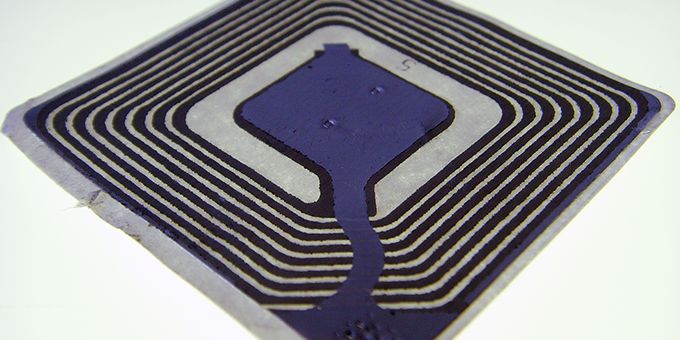By placing RFID tags onto agricultural products’ packages, farmers can determine the health condition of the product, making it convenient for processing companies to concurrently add information on the tag, such as enterprise codes, the processing date, batch processing, and package weight.
 How RFID Technology Is Used in Agriculture
How RFID Technology Is Used in Agriculture

Len Calderone
RFID is an acronym for “radio-frequency identification.” This technology uses digital data, which is encoded in RFID tags and read by a reader via radio waves. RFID is comparable to barcoding in that data from a tag is acquired by a device that stores the data in a database. RFID has the advantage over barcodes in that the RFID tag data can be read without being seen, whereas barcodes must be seen so that an optical scanner can read it.
RFID is part of a technology that is referred to as Automatic Identification and Data Capture (AIDC). AIDC automatically identifies an object, collects data about the object, and enters that data directly into computer systems without human intervention. Basically, RFID systems consist of three parts: an RFID tag, an RFID reader, and an antenna. A RFID tag contains an integrated circuit and an antenna, which is used to transmit data to the RFID reader, which then converts the radio waves into a practical form of data. This information is transferred through a communications interface to a main computer system, where the data is stored in a database and analyzed later.
.png)
TSL 1128 Bluetooth UHF RFID Reader
Items that are barcoded can easily be upgraded to a RFID system. RFID offers many improvements over the barcode. An RFID tag can hold much more data about an item than a barcode. Also, RFID tags are not susceptible to damages that often happen to barcode labels, like tearing and smudging.
RFID labels are used in inventory management, asset tracking, controlling access to restricted areas, ID Badging, and supply chain management.

RFID reader(portal) from Wikimedia
There are many uses for RFID technology in agriculture. Bales of hay can be tagged, capturing the date harvested, the field where it was harvested, the temperature, weight, moisture level and the nutritional information to be captured and stored. RFID has many potentials that busy farmers are seeking. RFID is non-contact. It has a high identification rate, mass memory, secure access, and can be integrated into an existing system without difficulty. Data collection in greenhouses is also doable with specialized RFID tags and readers, which are designed for warm and humid conditions.
The employment of RFID makes it possible to monitor the chain of perishable food and the expansion of new applications in fields like environmental monitoring, irrigation, specialty crops and farm machinery.
Editors Recommendation "Universal Automation in Agriculture"
The Taiwanese fruit producer Je-Nong Cooperative Farm is using a RFID solution to track the receipt and processing of its fresh fruit at its facility. By using passive ultrahigh frequency RFID tags attached to plastic crates, the company can monitor every phase that the fruit goes through, and the conditions within the coolers before the fruit is transported to stores throughout Taiwan, China, Japan and Korea.
By placing RFID tags onto agricultural products’ packages, farmers can determine the health condition of the product, making it convenient for processing companies to concurrently add information on the tag, such as enterprise codes, the processing date, batch processing, and package weight.
.png)
Commenco’s smart RFID tracking for marijuana growers
The farmers can track their goods via a computer network. Produce can be examined through a tag, quickly moving the inspection along. By reading the information stored on a RFID tag, a decision could be made whether a temperature shift will do harm to a fresh agricultural product or not. RFID can also be used to monitor climate conditions during transportation.
RFID can be employed to detect unauthorized openings of shipments during transportation, storage, distribution and sales. Before agricultural products enter a warehouse, the data stored on the RFID tag can be transmitted to a computer. The computer will release warehousing instructions as to the suitable rack and slots.
The correct inventory plan can be selected depending on the product specification and requirement. An information system will generate the picking and slotting order as soon as it receives a customer’s requisition. The operator can select the right product immediately by matching the information on the RFID tag with the requisition. Additional information, such as the transportation vehicle, distribution route, and schedule, has been embedded in the RFID tag during the distribution process.
The consumers can also benefit from the RFID application in sales. Consumers can gain basic information along the supply chain from the origin to the destination. RFID can help consumers to check the agriculture products’ safety.
A plant’s health management RFID can be used to check on a plant’s health though plant health inspection and certification, as well as agrochemical management. It can also help to cut down on the proliferation of plant pathogens. RFID is been inserted in many plants for different purposes. It is used in cactus to avoid theft, in citrus trees and cypress to monitor disease, and in grapevines for traceability and cloning selection.
RFID is used to evaluate the quality of apples by monitoring gases produced by apples such as ethylene. RFID tags integrated with gas sensors (O2 and CO2) is used for checking the freshness of broccoli. Semi-passive RFID is used for the calculation of the shelf life of lettuce, which is transported in refrigerated reefers, and for tracking the quality and shelf life of tomatoes.
.jpg)
Photo by Cristian Grumeza on Unsplash
A big-data capable IoT software platform can collect, filter, store and analyze the collected data. Growers can use state-of-the-art methods to deliver multiple crops a year by meticulously tracking growing conditions, such as light level, humidity, temperature and soil chemistry. The right IoT platform affords growers the ability to track these variables to supply real-time notification of changes and yield analytics to control and improve growing techniques.
RFID has limitations, just as bar codes do. A hundred bar codes on items within a box cannot be read, but RFID tags can be read as long as the items are not in a metal box as the RF waves will bounce off the metal. RFID tags can’t be always read with perfect accuracy since radio waves might be blocked or cancel each other out.
Many RFID tags can be detected and read remotely and at the same time, making the adoption of the latest technology innovations being the difference between profit and loss for farmers.
For additional information:
Editors Recommendation "Automation and Sensors in Hybrid Greenhouses"
The content & opinions in this article are the author’s and do not necessarily represent the views of AgriTechTomorrow
Comments (0)
This post does not have any comments. Be the first to leave a comment below.
Featured Product

